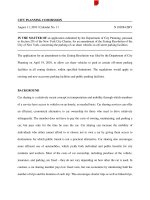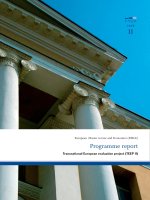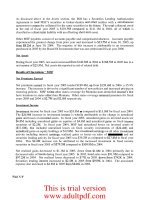Fuel Cell/Micro-Turbine Combined CycleFinal Report August 1998 – December 1999 By Larry docx
Bạn đang xem bản rút gọn của tài liệu. Xem và tải ngay bản đầy đủ của tài liệu tại đây (837.73 KB, 72 trang )
Fuel Cell/Micro-Turbine Combined Cycle
Final Report
August 1998 – December 1999
By
Larry J. Chaney
Mike R. Tharp
Tom W. Wolf
Tim A. Fuller
Joe J. Hartvigson
December 1999
DOE Contract: DE-AC26-98FT40454
McDermott Technology, Inc.
1562 Beeson Street
Alliance, OH 44601
Northern Research and Engineering Corporation
32 Exeter Street
Portsmouth, NH 03801
Disclaimer
This report was prepared as an account of work sponsored by an agency of the United
States Government. Neither the United States Government nor any agency thereof, nor
any of their employees, nor contractor nor any subcontractor thereunder, makes any
warranty, express or implied, or assumes any legal liability or responsibility, for the
accuracy, completeness, or usefulness of any information, apparatus, product, or process
disclosed, or represents that its use would not infringe privately owned rights. Reference
herein to any specific commercial product, process, or service by trade name, trademark,
manufacturer, or otherwise does not necessarily constitute or imply its endorsement,
recommendation, or favoring by the United States Government or any agency thereof.
The views and opinions of authors expressed herein do not necessarily state or reflect
those of the United States Government or any agency thereof.
Disclaimer
McDermott Technology, Inc. assumes no liability with respect to the use of, or for
damages resulting from the use of, or makes any warranty or representation regarding any
information, apparatus, method, or process disclosed in this report.
McDermott Technology, Inc. expressly excludes any and all warranties either expressed
or implied, which might arise under law or custom or trade, including without limitation,
warranties of merchantability and of fitness for specified or intended purpose.
ABSTRACT
A wide variety of conceptual design studies have been conducted that describe ultra-high
efficiency fossil power plant cycles. The most promising of these ultra-high efficiency
cycles incorporate high temperature fuel cells with a gas turbine. Combining fuel cells
with a gas turbine increases overall cycle efficiency while reducing per kilowatt
emissions. This study has demonstrated that the unique approach taken to combining a
fuel cell and gas turbine has both technical and economic merit. The approach used in
this study eliminates most of the gas turbine integration problems associated with hybrid
fuel cell turbine systems. By using a micro-turbine, and a non-pressurized fuel cell the
total system size (kW) and complexity has been reduced substantially from those
presented in other studies, while maintaining over 70% efficiency. The reduced system
size can be particularly attractive in the deregulated electrical generation/distribution
environment where the market may not demand multi-megawatt central stations systems.
The small size also opens up the niche markets to this high efficiency, low emission
electrical generation option.
i
Table of Contents
List of Acronyms and Abbreviations 1
Executive Summary 2
1.0 Introduction 3
2.0 Results and Discussion 5
2.1.1 Process Description 5
2.1.2 Engine/Fuel Cell Integration Concepts 10
2.1.3 Design Assumptions 21
2.1.4 Major Equipment 23
2.1.5 Input Data and Heat and Material Balance 28
2.1.6 Modeling Approach and Methodology 28
2.2 Process/Equipment Uncertainties and Development Requirements 36
2.2.1 Fuel Cell Issues 36
2.3 System Capital Costs 42
2.4 Annual Operating Costs 43
2.5 Opportunities for Improvement and Suggested Work 43
2.5.1 Market Introduction - 200 kW System 43
3.0 Conclusions 49
4.0 References 50
ii
List of Figures
Figure 1 - Cpn 4 Stack Module 5
Figure 2 - Fuel Cell Micro Turbine Combined Cycle 7
Figure 3 - Concept A, Isometric View 12
Figure 4 - Concept A, Plan View 13
Figure 5 - Concept A, Elevation View 14
Figure 6 - Concept B, Isometric View 15
Figure 7 - Concept B, Isometric View 16
Figure 8 - Concept B, Plan View 17
Figure 9 - Concept B, Elevation View 18
Figure 10 - Recuperator Arrangement 21
Figure 11 - Compressor Flow 32
Figure 12 - Exhaust Temperature 32
Figure 13 - Engine Electrical Power Output 33
Figure 14 - Hot Side Recuperator Inlet Temperature 33
Figure 15 - Compressor Flow 34
Figure 16 - Compressor Pressure Ratio 34
Figure 17 - Compressor Efficiency 35
Figure 18 - Overall Expansion Efficiency 35
Figure 19 - PSOFC Performance Map 41
Figure 20 - Current Density Vs. Cell Voltage And Power Density 44
Figure 21 - NREC PowerWorks 70kWe gas-turbine cogeneration system 48
Figure 22 - PowerWorks 100RT Chiller with direct-drive centrifugal compressor 49
Figure 23 – 180 kW PSOFC/MicroTurbine System 54
iii
List of Tables
Table 1 - State Parameters for 700 kW Fuel Cell/Micro-Turbine Combined Cycle 6
Table 2 - Design Parameters for 700 kW Fuel Cell/Micro-Turbine Combined Cycle 8
Table 3 - Performance Study for 700 kW Fuel Cell/Micro-Turbine Combined Cycle 8
Table 4 - Component Duty Summary for 700 kW fuel Cell/Micro-Turbine Combined
Cycle 9
Table 5 - Hybrid Recuperator Options 21
Table 6 - Key System Parameters for 700 kW Fuel Cell/Micro-Turbine Combined
Cycle 22
Table 7 - Comparison of Transmission Efficiencies 26
Table 8 - Component Pressure Losses 29
Table 9 - PSOFC/Microturbine Capital Costs 42
Table 10 - State Parameters for 180 kW Fuel Cell/Micro-Turbine Combined Cycle 46
Table 11 - Design Parameters for 180 kW Fuel Cell/Micro-Turbine Combined Cycle 46
Table 12 - Performance Summary for 180 kW Fuel Cell/Micro-Turbine Combined
Cycle 48
Table 13 - Component Duty Summary for 180 kW Fuel Cell/Micro-Turbine Combined
Cycle 48
1
List of Acronyms and Abbreviations
AC Alternating Current
AES Advanced Energy System
ASR Area Specific Resistance (O*cm
2
)
BOP Balance of Plant
cfm Cubic feet per minute
COE Cost of Electricity
Cpn
TM
Co-planar, n-stack
DC Direct Current
DOE United States Department of Energy
GRI Gas Research Institute
HEFPP High Efficiency Fossil Power Plant
HHV Higher Heating Value
HT High Temperature
kW Kilowatt (1000 W)
kWe Kilowatt Electric (1000 W)
LHV Lower Heating Value
MM Btu Million British Thermal Units
MTI McDermott Technology Inc.
MW Megawatt (1,000,000 W)
NREC Northern Research and Engineering
ODS Oxide Dispersion Strengthened
OEM Original Equipment Manufacturer
PLC Programmable Logic Controller
PM2000 Advanced metallic material from Plansee GmbH, Germany
PowerWorks™ NREC’s micro turbine
PSOFC Planar Solid Oxide Fuel Cell
SI SI is an abbreviation for “Le Systeme Internationale d’Unites.”
SOFCo Solid Oxide Fuel Cell Company
Research and Development Limited Partnership with MTI
andCeramatec
TIT Turbine Inlet Temperature
TCE Coefficient of thermal expansion
VHT High Temperature
2
3
EXECUTIVE SUMMARY
A wide variety of conceptual design studies have been conducted that describe ultra-high
efficiency fossil power plant cycles. The most promising of these ultra-high efficiency
cycles incorporate high temperature fuel cells with a gas turbine. Combining fuel cells
with a gas turbine increases overall cycle efficiency while reducing per kilowatt
emissions. Fuel cells are widely recognized as one of the most promising family of
technologies to meet future power generation requirements. Since fuel cells directly
convert fuel and an oxidant into electricity through an electrochemical process, they can
achieve operating efficiencies approaching 70% - nearly twice the efficiency of
conventional internal combustion engines. Fuel cells produce very low levels of
pollutant emissions (NO
x
, SO
x
, and CO
2
). They are also amenable to high-volume
production as standardized power modules.
This conceptual study has demonstrated that the unique approach taken to combining a
fuel cell and gas turbine has both technical and economic merit. By using a micro-
turbine, and a non-pressurized fuel cell the total system size (kW) has been reduced
substantially from those presented in other studies, while maintaining over 70%
efficiency. The approach used in this study eliminates most of the gas turbine integration
problems associated with hybrid fuel cell turbine systems. The reduced system size can
be particularly attractive in the deregulated electrical generation/distribution environment
where the market may not demand multi-megawatt central stations systems. The small
size also opens up the niche markets to this high efficiency, low emission electrical
generation option.
While the study has discovered no technical obstacles to success, a sub-scale technology
demonstration would reduce the risk of performance and enable a full-scale commercial
offering. Demonstrating a full size micro-turbine, with a single fuel cell module would
prove the concept as well as the major components and balance of plant that would be
needed in a full-scale system.
4
1 INTRODUCTION
Global demands for additional power generation over the next twenty years are about 2
million megawatts, of which 490,000 megawatts are projected to be powered by natural
gas (McDermott internal study). As a result of utility deregulation in the U.S., concerns
with real and perceived health issues, and capital costs associated with the distribution
and transmission of electricity, approximately 30% of this additional natural gas capacity
will consist of modular power plants located close to the user. Fuel cells combined with
a micro-turbine are a logical candidate to meet this need. They offer modularity,
increased fuel efficiency, and low emissions. Major gas and electric utilities have shown
an interest in investing in both fuel cells and micro-turbines (McDermott confidential
communications).
A wide variety of conceptual design studies have been conducted that describe ultra-high
efficiency fossil power plant cycles. The most promising of these ultra-high efficiency
cycles incorporate high temperature fuel cells with a gas turbine. Combining fuel cells
with a gas turbine increases overall cycle efficiency while reducing per kilowatt
emissions. Fuel cells are widely recognized as one of the most promising family of
technologies to meet future power generation requirements. Since fuel cells directly
convert fuel and an oxidant into electricity through an electrochemical process, they can
achieve operating efficiencies approaching 70% - nearly twice the efficiency of
conventional internal combustion engines. Fuel cells produce very low levels of
pollutant emissions (NO
x
, SO
x
, and CO
2
). They are also amenable to high-volume
production as standardized power modules.
The operating characteristics of a fuel cell/micro-turbine power plant have several
important ramifications to the energy service industry. Successful development and
commercialization of dispersed fuel cell/micro-turbine power generators will allow:
• Siting flexibility with environmentally friendly energy systems,
• Improved quality of energy services at a reduced cost,
• Ability to rapidly respond to customer needs with modular energy systems,
• Improved utilization of clean natural gas, of which the nation has an abundant
domestic supply, and
• Facilitate implementation of clean air policies
This report documents the results of a conceptual technical and economic evaluation of
an innovative and unique integration of high temperature fuel cells with a gas turbine.
The technical approach described in this program focuses on a planar solid oxide fuel cell
(PSOFC) combined with a micro-turbine. PSOFCs have the potential for low cost
manufacturability. McDermott Technology Inc. (MTI) has a development program in
progress to address various methods of low cost, high volume manufacturing of PSOFCs
and stacks. A low cost PSOFC combined with a sub-megawatt gas turbine creates a
highly attractive product for the deregulated power market. Other studies have focused
on a pressurized fuel cell gas turbine system. This study presents a unique, non-
5
pressurized approach to combining PSOFCs with gas turbines. One of the key issues
addressed in this study is that of system economics versus efficiency. The objective is to
optimize the economic viability associated with the development of PSOFC/micro-
turbine systems while balancing the need for operating efficiency and low emissions.
Part of this economic analysis will include an economic analysis of the PSOFC stack
operating point.
Based upon previous analyses by MTI and other solid oxide fuel cell related companies,
PSOFC/turbine systems have been shown to be capable of operating at efficiencies
greater than 70%. Overall, the HEFPP program goals of developing a fuel cell / turbine
power plant concept of 20 MW with a net efficiency of greater than 70% have been met.
The goals have been exceeded in that the efficiency target of 70% has been met at a sub-
megawatt plant size. The smaller plant size gives more flexibility in responding to
market demands.
6
2 RESULTS AND DISCUSSION
2.1 Fuel Cell / Micro-turbine system analysis
The analysis of the fuel cell micro turbine combined cycle is described below. The
overall process is described first followed by engine fuel cell integration concepts, design
assumptions, a description of the major equipment, input data, a heat and material
balance and then the modeling approach and methodology.
2.1.1 Process Description
This design utilizes a unique combination of fuel cell, turbine and recuperator to achieve
a highly efficient cycle in a small, compact market-driven size. The flow and heat
requirements of components in the micro-turbine and Solid Oxide Fuel Cell Company
(SOFCo) Cpn
TM
(Co-planar, n-stack) fuel cell module have been matched, resulting in a
highly integrated package. The micro-turbine is a 70 kW gas turbine engine under
development by Northern Research and Engineering Corporation (NREC). The SOFCo
Cpn
TM
concept evolved from recognizing the impact of the balance of plant (BOP) on the
economy and efficiency of the total fuel cell system. The design optimizes the total fuel
cell system and maximizes the efficiency of the system while simultaneously reducing
the number of high temperature components peripheral to the stack. The Cpn
TM
module,
shown in Figure 1, consists of a multi-stack arrangement that enhances efficiency through
effective thermal coupling of the stacks and the fuel processors. The Cpn
TM
power
system is comprised of planar PSOFC stacks, fuel processor components and the BOP
equipment. The most significant feature of the Cpn
TM
is the Thermally Integrated
PSOFC Module that houses the fuel cell stacks, reformer catalyst tubes, and a spent fuel
burner.
Figure 1: Cpn 4 stack module
7
A process schematic for the fuel cell/micro-turbine combined cycle is shown in Figure 2.
The state parameters for the system are listed in Table 1, and the design parameters used
in the system analysis are listed in Table 2. The air is first compressed in the compressor
at a 3:1 pressure ratio. The air is then heated to 1600
o
F in a high temperature recuperator
by utilizing exhaust gas from the Cpn
TM
module. The hot, high-pressure air is then
expanded through the turbine providing power for the compressor and electrical
generation. The turbine produces 68.8 kWe of net electrical power or 9.5% of the total.
The air is then sent to the fuel cell.
Natural gas is mixed with steam that was generated in the steam generator coil, and the
mixture is then heated further in the fuel heater. The heated fuel/steam mixture is then
sent to the steam reformer. In the steam reformer, the fuel-steam mixture passes over
steam reforming catalyst and is processed into hydrogen rich reformate and sent to the
fuel cell. The hydrogen and carbon monoxide in the fuel are electrochemically oxidized
in the fuel cell producing electrical power. The fuel cell produces 657.6 kW of electrical
power or 90.5% of the total. The unreacted fuel exiting the fuel cell is burned with the
fuel cell cooling air in the fuel cell module enclosure, further boosting the exhaust
temperature and providing heat to drive the steam reforming reactions in the steam
reformer. The hot gas leaving the Cpn
TM
is then sent to the high temperature recuperator
State Point
Flow
Temperature
Pressure
Enthalpy
kg/s (lbm/hr)
C (F)
kPa (psi)
J/kg (Btu/lbm)
1 0.662 (5256) 15 (59) 101.3 (14.7) -1.35e5 (-58.04)
2 0.622 (5256) 178 (352) 304 (44.1) 3.11e4 (13.35)
3 0.662 (5256) 871 (1600) 300.9 (43.6) 8.01e5 (344.37)
4 0.662 (5256) 872 (1600) 293.5 (42.6) 8.01e5 (344.37)
5 0.622 (5256) 639 (1182) 106.9 (15.5) 5.31e5 (228.29)
6 0.274 (2175.7) 862 (1583) 104.4 (15.1) 7.72e5 (331.90)
7 0.022 (177) 15 (59) 204.7 (29.7) -4.74e6 (-2037.83)
8 0.040 (315.4) 25 (77) 120 (17.4) -1.60e7 (-6878.76)
9 0.040 (315.4) 108 (226) 120 (17.4) -1.33e7 (-5717.97)
10 0.062 (492.4) 95 (202) 120 (17.4) -1.02e7 (-4385.21)
11 0.062 (492.4) 253 (488) 120 (17.4) -9.81e6 (-4217.54)
12 0.062 (492.4) 816 (1500) 120 (17.4) -3.81e6 (-1638.01)
13 0.138 (1091.7) 862 (1583) 116.8 (16.9) -9.96e6 (-4282.03)
14 0.724 (5748.4) 913 (1675) 103.7 (15.0) -1.31e6 (-563.20)
15 0.724 (5748.4) 910 (1670) 103.7 (15.0) -1.32e6 (-567.50)
16 0.724 (5748.4) 358 (676) 103.6 (15.0) -2.02e6 (-868.44)
17 0.724 (5748.4) 330 (626) 102.8 (14.9) -2.06e6 (-885.64)
18
0.724 (5748.4)
200 (391)
102.6 (14.9)
-2.21e6 (-950.13)
Table 1 - State Parameters For
700 kW Fuel Cell/Micro-turbine Combined Cycle
8
where it heats the compressed air, and then is sent to the fuel heater where it heats the
fuel and steam mixture. The fuel heater exhaust is used to provide heat to generate the
steam that is mixed with the natural gas. The exhaust exits the process at 200
o
C. The
exhaust could be used to generate low-pressure process steam or space heating in a
cogeneration heat exchanger.
Figure 2: Process Schematic for the Fuel Cell MicroTurbine Combined Cycle
Water
Natural
Gas
AIR
REFORMED FUEL
EXHAUST
Fuel Cell
Burner
Steam Reformer
Compressor
Turbine
Fuel Heater
Recuperator
(1583 F)
(177 lbm/hr)
1
2
3
4
6
7 10
11
12
13
15
16
658 kW
68.7 kW
(5256 lbm/hr)
0.662 kg/s
(12.2 "w.c.) dP
3.04 kPa dP
871 C (1600F)
862 C
816 C (1500 F)
(1675 F)
913 C
910 C (1670 F)
(676 F)
358 C
18
8
(315.4 lbm/hr)
0.04 kg/s
Steam Generator
9
Steam
0.022 kg/s
(2.9 "w.c. dP)
0.72 kPa dP
(488 F)
253 C
17
(391 F)
200 C
(1.0 "w.c. dP)
0.25 kPa dP
5
Startup Burner
FUEL
CELL
MODULE
14
9
The performance of the fuel cell /micro-turbine combined cycle is summarized in Table
3, and the duties of heat transfer equipment are listed in Table 4. The process produced
726.4 kWe of power at 71.2% LHV efficiency. For the HEFPP program requirement of a
multi-megawatt system, the process can be considered a module. Twenty-eight modules
would produce 18.4 MW. The modular concept is an attractive alternative for the power
plant, providing flexibility in turndown, dispatching, and annual maintenance downtime.
Fuel Natural gas
0.96 CH
4
, 0.02 N
2
, 0.02 CO
2
LHV = 4.81E7 J/kg (20,659 Btu/lbm)
Turbine pressure ratio 3:1
Recuperator effectiveness 0.947
Fuel cell 15,616 cells
Operating voltage 0.76 V/cell
System heat loss 0.5% of heat input
Inverter efficiency 95%
Generator efficiency 98%
Gear box loss
5%
Table 2 - Design Parameters for
700 kW Fuel Cell/Micro-Turbine Combined Cycle
Mass flow rate of natural gas 80.3 kg/hr (177 lbm/hr)
Gas flow * LHV 1,072,897 W (3,656,643 Btu/hr)
Gross Power 761 kW
Net Power 726.4 kW
Efficiency, LHV 71.2
Contributions to Power
Fuel cell 657.6 kW
Turbine 68.8 kW
Inverter loss -34.6 kW
Generator loss Included in turbine power calculation
Gear box loss Included in turbine power calculation
Table 3 - Performance Summary for
700 kW Fuel Cell/Micro-Turbine Combined Cycle
10
Fundamental requirements for the engine operating in a PSOFC system are as follows:
• During the power plant startup cycle, the engine provides hot air for PSOFC
preheat and eventual power generation. Through the preheat period (~20 hours)
the engine will operate at a pre-selectable constant turbine inlet temperature,
delivering between 45 and 80 kWe AC power to the grid depending on ambient
temperature and the turbine-inlet temperature set point. The cell remains inactive
during this phase.
• At the conclusion of the preheat cycle the cell will have reached thermal
equilibrium at the engine exhaust temperature of roughly 1200
o
F, sufficient for
reformer operation. The PSOFC controller then modulates fuel supply to the
reformer in order to drive recuperator-inlet temperature toward the 1740
o
F design-
point level. As recuperator preheating occurs fuel supply to the engine combustor
is reduced gradually to zero, maintaining turbine-inlet temperature roughly at the
1600
o
F design target. Except for monitoring of safety conditions by the engine
controller, engine operation is governed at this point entirely by the PSOFC
controller.
• During normal “design-point” operation, running with the combustor off, engine
power augments PSOFC electrical output roughly by 10% while supplying hot air
to the cell. The engine controller continues to monitor safety conditions, alerting
the PSOFC controller in the event of a fault.
• Under part-load demand with the combustor off, the engine provides reduced
electrical output and flow, but generally a higher fraction of PSOFC power than at
design conditions.
Additional flexibility in the management of the power plant starting sequence is made
possible with the use of the hydraulic drive system fitted with this engine. This
proprietary NREC technology relies on a miniature hydraulic turbine mounted on the
gasifier shaft, fed by a high-velocity jet of lubricating oil drawn from the engine sump.
An attractive feature of this system for the current application is its ability to run for
extended periods, delivering 200 to 400 cfm to the PSOFC. This may be applied as a
pre-starting or cool-down operating mode.
Component Duty (kW)
Fuel heater 24.2 (82,703 Btu/hr)
Reformer 372.4 (1,270,532 Btu/hr)
Recuperator 510.2 (1,741,011 Btu/hr)
Spent fuel burner 42.5 (144,979 Btu/hr)
Steam generator 110.2 (375,896 Btu/hr)
Table 4 - Component Duty Summary for
700 kW Fuel Cell/Micro-Turbine Combined Cycle
11
During normal power plant operation the combustor is not fired. The engine power and
flow under these circumstances depends entirely on turbine-inlet temperature and
ambient conditions, the former dependent chiefly on recuperator-inlet temperature. The
generator remains synchronized to the utility grid in all conditions. An attribute of this
system is that turbine-inlet temperature will not drop substantially during power plant
turndown, hence the engine will continue to run at high efficiency. At low PSOFC
current density, with flow roughly at the design value, oxidant utilization will be low,
boosting PSOFC efficiency.
2.1.2 Engine/Fuel cell Integration Concepts
The critical engine/fuel cell integration challenge is the development of a recuperator
capable of accepting gas-inlet temperatures in excess of 1740
o
F, well beyond the
capability of superalloys in this service. The design concepts developed in this study rely
on the use of the advanced material PM2000 (Plansee GmbH, Germany), a so-called
oxide-dispersion-strengthened (ODS) powdered-metal alloy. Although some questions
remain regarding formability of this material in our manufacturing process, provided the
problems can be overcome (and we expect that they can) a recuperator very similar in
design to that of our current unit will be suitable. This greatly simplifies the job of
building the recuperator and of packaging it in our engine.
Despite our optimism that PM2000 can be made to work, we’ve allowed in our cost
projections for a more proven alternative solution in the form of a “hybrid” recuperator.
This is the concept put forth in our original proposal, which makes use of a high-
temperature tube-shell unit inserted in series with a recuperator similar to our current
design. Compared to the single-recuperator approach this concept carries a substantial
cost penalty, mostly from the high cost of the tube-shell unit, but also from costs
associated with modifying the existing recuperator case and supports. The hybrid
approach also carries a performance penalty in the form of additional pressure loss for the
same thermodynamic effectiveness.
The hybrid concept has been evaluated to the extent that rough cost projections can be
made, but explicit design layouts have been developed only for the single high-
temperature recuperator approach. In part this reflects our view as to the superiority of
the latter concept, and our optimism that it can be made to work.
The remaining integration challenges are largely associated with ducting hot gases with
acceptable pressure and heat losses.
The engine modeled in this study is based on NREC’s PowerWorks™ engine. The
PowerWorks™ engine was originally developed in the early 1980s under GRI
sponsorship. It is now in it’s fourth generation of development. It incorporates a single-
spool gasifier and a low-speed power turbine. A single-stage gear box reduces the 44,000
RPM power turbine to 3600 RPM so that a conventional generator can be used. As a
stand-alone machine the PowerWorks engine is tightly packaged to achieve these
12
objectives, and significant re-orientation of components is needed to allow for ducting
transitions to the fuel cell. The following existing engine systems will require substantial
rework:
ü chassis
ü compressor-recuperator duct
ü recuperator inlet plenum/header
ü exhaust plenum
ü lubrication-system piping
Two system layouts (Concepts ‘A’ and ‘B’) are shown in Figures 3 through 9. Both
concepts make use of a single recuperator core identical in size to the current
PowerWorks recuperator, consistent with the use of the advanced high-temperature
material mentioned above.
Both concepts are topologically identical, and there is no clear choice with regard to ease
of fabrication or cost. Pressure losses will be roughly comparable, the specifications
discussed earlier having been used as an approximate basis for pipe sizing in both cases.
Concept A has a small advantage in terms of exposed surface area of hot ducting, but at
the expense of slightly more challenging fabrication requirements. Concept A may also
pose a bit more difficulty in achieving a flow balance among the modules, and service
accessibility looks to be not as good. For these reasons, Concept B has a slight edge, but
the choice may ultimately come down to site requirements such as proximity of
inlet/exhaust ducting and availability of floor space.
Identical construction is assumed for all fuel cell modules in both concepts. Because of
the requirement for vertical stacking of the cells, the gas-inlet aperture on all but the
uppermost module in the stack will face its neighbor above. This requires that a spacer
be included between each module to provide area for a supply duct. It is assumed that
these features, the spacers and supply duct, will be incorporated into the module design.
13
Figure 3 Concept A Isometric View
F.C. DISCHARGE COLLECTOR (SHOWN
INSULATED)
RECUPERATOR INLET
DUCT
RECUPERATOR
COMPRESSOR
AIR
INLET
F.C. DISCHARGE MANIFOLD (1 OF 4) (SHOWN
INSULATED)
F.C. INLET COLLECTOR (SHOWN
INSULATED)
EXHAUST STACK
FUEL/H2O
IN
FUEL PREHEATER
POWER
TURBINE
GASIFIER TURBINE
GEARBOX
GENERATOR
CONCEPT
COMBUSTOR
F.C. INLET MANIFOLD (1 OF 4) (SHOWN INSULATED)
FUEL MANIFOLD
POWER-TURBINE DISCHARGE
(F.C. INLET)
14
Figure 4 Concept A, Plan View
F.C. INLET DUCT
(16 TOTAL)
CONCEPT A
15
Figure 5 Concept A, Elevation View
CONCEPT A
RECUPERATOR
EXHAUST PLENUM
COMBUSTOR
EXHAUST STACK
16
Figure 6 Concept B, Isometric View
CONCEPT B
FUEL/H2O IN
F.C. DISCHARGE COLLECTOR (SHOWN INSULATED)
F.C. INLET COLLECTOR (SHOWN
INSULATED)
F.C. DISCHARGE MANIFOLD (1 OF 4) (SHOWN INSULATED)
GENERATOR
GEARBOX
POWER TURBINE
FUEL PREHEATER
EXHAUST PLENUM
EXHAUST STACK
GASIFIER TURBINE
COMPRESSOR
AIR INLET
RECUPERATOR & COMBUSTOR
RECUPERATOR INLET DUCT
17
Figure 7 Concept B, Isometric View
CONCEPT B
18
Figure 8 Concept B, Plan View
F.C. INLET DUCT
(16 TOTAL)
CONCEPT B









